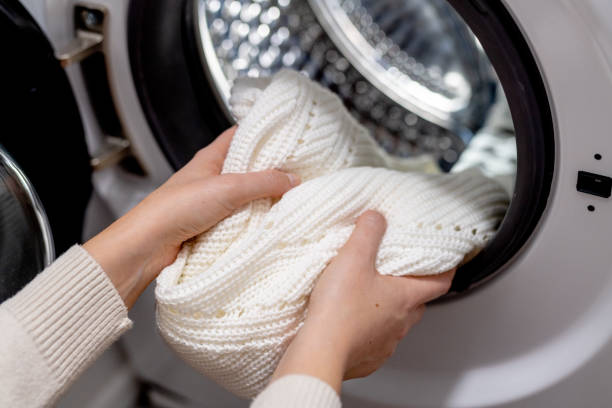Keeping your white clothes brilliantly white is a common challenge that many face but often struggle to achieve. Fading, yellowing, and staining are frequent issues that can leave your once-pristine garments looking tired and dull. The good news is that with a few simple yet effective laundry tips, you can maintain the brightness of your white clothes. This article provides 13 essential tips to help you achieve that crisp, clean look you desire, ensuring your whites remain vibrant for years. From understanding the basics of sorting laundry to exploring advanced whitening techniques, you’ll find all you need to know right here.
Understanding the Basics

One of the golden rules of laundry is to keep whites separate from colored clothes. Mixing can cause dye transfer, resulting in discolored or grayish-white garments. By diligently sorting your laundry, you can avoid this common pitfall. Ensure you have separate piles for whites, lights, darks, and delicates to maintain the integrity of your fabrics.
Properly sorting your laundry is crucial to maintain the quality of your clothes. Effective sorting ensures that your whites remain pristine and your colored clothes retain their vibrancy. Here’s a simple way to categorize:
- Whites: Bed linens, socks, underwear, and white shirts.
- Lights: Pastel colors, light greys, and other light hues.
- Darks: Blacks, navies, and other dark-toned fabrics.
- Delicates: Lingerie, silk items, and hand-wash only fabrics.
Choosing the Right Detergent
Selecting the right detergent can make a significant difference. Opt for high-efficiency detergents specifically formulated for modern washing machines. These detergents are designed to clean effectively while preserving the brightness of whites. Avoid using excessive detergent, as this can leave residue, making your clothes appear dull.
Pre-Treatment Techniques
Pre-treating stains is an essential step. Addressing stains immediately can prevent them from setting in. Use a dab of detergent or a specialized stain remover. For heavily soiled whites, soak them in a solution of water and oxygen bleach for at least 30 minutes before laundering. This approach can help lift stubborn stains and brighten the fabric.
Optimal Washing Practices
The water temperature used during washing plays a pivotal role. Most white clothes can tolerate warm to hot water, which helps eliminate bacteria and grime. Always check the care labels to ensure you’re using the correct temperature for each fabric type. Using the wrong temperature can damage delicate fabrics or fail to properly clean heavily soiled items.
Selecting the right wash cycle and settings is crucial. For heavily soiled whites, choose a longer, more intense wash cycle. This ensures thorough cleaning. For delicate white garments, opt for a gentle cycle to maintain fabric integrity. Proper use of washing machine settings can significantly enhance the lifespan and brightness of your whites.
Advanced Whitening Techniques
When it comes to bleaching, use chlorine bleach sparingly, as it can weaken fabric fibers over time. Instead, consider using oxygen bleach, which is more fabric-friendly and equally effective at maintaining whiteness without causing damage. Here are the differences between the most common types of bleach:
| Type of Bleach | Pros | Cons |
|---|---|---|
| Chlorine Bleach | Strong whitening power, effective at killing bacteria | Can weaken fabrics, may cause yellowing |
| Oxygen Bleach | Gentler on fabrics, environmentally friendly | Less effective on tough stains |
The Magic of Baking Soda and Vinegar
Baking soda and vinegar can work wonders for maintaining white clothes. Add half a cup of baking soda to your laundry to boost detergent performance. During the rinse cycle, use white vinegar to help remove detergent residue and enhance fabric softness. These common household items can significantly elevate the cleaning efficiency and brightness of your whites.
Drying and Storage Tips
How you dry your white clothes is just as important as how you wash them. Line-drying outside in the sun can naturally bleach and brighten your garments. If line-drying isn’t an option, use a low heat setting on your dryer and remove clothes while they’re slightly damp to prevent yellowing. Proper drying techniques can preserve the quality and appearance of your white clothes.
Storing white clothes correctly can prevent them from becoming yellowed or dingy. Avoid using plastic bags, as they can trap moisture and cause yellowing. Instead, store whites in breathable fabric bags. Ensure that clothes are clean and completely dry before storing them to avoid mildew growth. Proper storage prolongs the lifespan and appearance of your whites.
Conclusion
Keeping white clothes brilliantly white may require extra effort, but it’s possible with a consistent and thoughtful laundry routine. By following these 13 essential tips, you can ensure your whites stay radiant and pristine for years to come. From selecting the right detergent to proper storage techniques, every step plays a vital role in maintaining the brightness of your white garments.
FAQs
Q1: Can I use bleach on all white clothes?
Not all fabrics tolerate bleach well. Always read the care label and test on a small, inconspicuous area before applying it to the entire garment.
Q2: How frequently should I wash white clothes?
Whites should be washed after every wear, especially items like underwear and socks, to maintain their brightness and hygiene.
Q3: Can I mix baking soda and vinegar in the same wash?
It’s best to use baking soda during the wash cycle and vinegar during the rinse cycle to avoid neutralizing their effects.
Q4: What should I do if my whites turn yellow?
Pre-soak in an oxygen bleach solution before laundering and avoid direct sunlight after washing, as this can exacerbate yellowing.
Q5: How can I prevent white clothes from becoming dingy?
Besides following the outlined tips, make sure to regularly clean your washing machine to avoid residual build-up that can transfer to your clothes.
